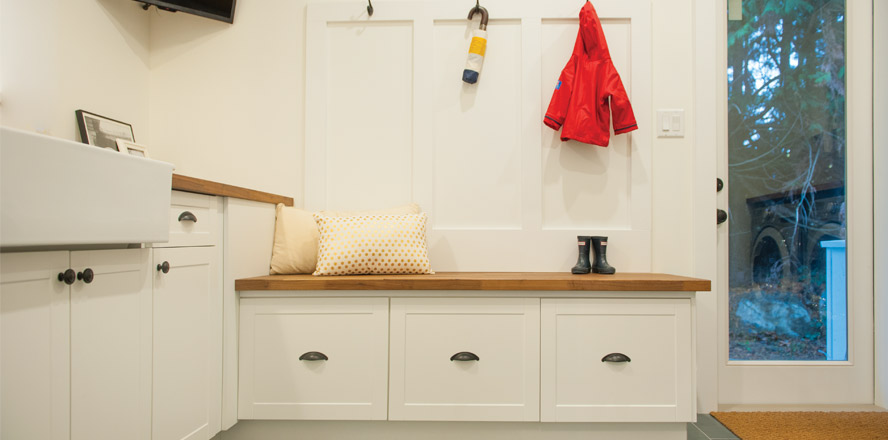by Janice Henshaw –
As the summer nights begin to shorten, we may discover that we can’t push and prod our expanded outdoor furniture and camping equipment into their winter storage slots. In houses with ample built-in cabinets and large garages, this may not be a problem, but for those of us who live in more minimalist housing, finding space for our treasures can be a real pain in the derrière.
If we plan on staying in our current home, what can we do to create more storage? Renovating is one option. A second is improving the organization of what we have. But before diving headlong into either option, here are some thoughts gleaned from the joys and travails of a few renovations.
Create a budget – don’t renovate without one!
If contemplating a renovation, a budget is the first step in making dreams take on structure. Budgets help evaluate projects and determine if sufficient funds are available to cover construction, materials and the many potential cost variables. It’s always a good idea to include contingency funds for unanticipated expenses.
An Excel spreadsheet is a handy tool for budget development and tracking, and there are also budgeting apps available online. With input from a contractor, it’s possible to list planned items and their anticipated costs. As purchases are completed, the spreadsheet can be updated automatically and keep us aware of how close we are to projections. Ideally, a little more spent on one part of the project can be offset by savings on another part (or by the contingency items). In this way, it’s possible to avoid the very real shock of seeing how much a “little bit extra here, and a little bit extra there” can add up to on the final bill.
Timing is crucial.
Expectations need to be made clear between all parties. A failure to set clear timing expectations can lead to all sorts of problems and costs. For example, several years ago, a plumbing company promised me that they would show up to renovate my one and only bathroom first thing on a specified Monday. Before leaving for work that morning, as agreed, I removed the old toilet and put it out in the backyard. When I got home that night, it was still sitting out there, glowing white in the moonlight. It was another two weeks before the plumber showed up. Lesson learned: always call to confirm schedules.
Work with great people.
Not all contractors and tradespeople are created equal, and the person willing to do a job the cheapest or soonest may not be the best. There’s no substitute for doing your online research, asking around at established stores and checking references for big jobs. Having the right team can make all the difference.
Communication with your contractor is vital.
I have heard some sad stories about new builds and renovations that have ended up in conflict between the homeowners and the contractor. Help avoid this by ensuring that you and your contractor both agree on your spreadsheet and share the same vision for your renovation. Also, ensure that you are clear about what happens after the renovation is finished and paid in full. What agreement or warranty is in place if, in the months following the renovation, the sink starts to leak or the pantry door starts to stick? Get it all in writing. Ensure that you and your contractor are both creating the same “story.” After all, a great, on-time and on-budget renovation is in everyone’s best interest, particularly when you work with good people who have an incentive to keep up their reputation.
Once all the fine details have been worked out, and the contract is signed, it’s time to move on to the many finishing decisions. The kitchen, often the central gathering point for our friends and family, is best designed by an expert in the field. Jessica Kwasnica, owner and principal designer at Seaside Cabinetry & Design, says that designing a well-organized kitchen is key and that using inserts helps achieve maximum storage efficiency.
One insert offered at Seaside Cabinetry is a specific recycling pullout that they put in almost every kitchen. Other popular inserts include spice/oil pullouts, garbage bins, utensil, cutlery and knife storage, and even a roll-out for pet dishes. “Most people are hoping to keep their kitchen countertops free of clutter,” says Jessica, “so designing a kitchen with inserts for all items is an important step in achieving a clean and organized look.”
If renovation is not in your plans, how about some unique storage ideas?
Andi Hook, owner/designer at Hook & Hook Renovations, knows that storage options are endless when she designs a custom kitchen, but for those of us who don’t have a renovation planned for the near future, here are three of her easy storage ideas.
Idea #1: Do you dread looking for the lids to go with your pots? Purchase several packages of self-sticking, plastic hooks…Measure your lid size and place the hooks (two per lid) on the inside of your cabinet door. The lids will rest nicely on the hooks.
Idea #2: Not enough cabinets? No pantry? Or maybe you rent and need a storage solution that you can take with you? Purchase a leaning ladder bookcase to store food, dishes and cookbooks in style.
Idea #3: Does the upper run of cabinets stop short? You can make that space functional and attractive by adding baskets or wooden boxes to store kitchen gadgets or your root veggies. At floor level, if there is a toe kick, you can add custom storage drawer containers.
Moving from the kitchen to the bedroom – how about storing items under your bed?
Muffet & Louisa, Sidney’s home and décor store, sells a beautiful bed that is built in Victoria by Fawcett Manufacturing. Owner Muffet Billyard-Leake explains that it incorporates a “nifty lift” so that linens, paddleboards, or even a guitar collection can be stored under the mattress platform. The depth of this space can be adjusted depending on what the owner wants to store.
Do you dance with rolling shampoo bottles in the shower?
Laura McLarty, the owner of Flush Bathroom Essentials, says that the best way to keep showers clean and clutter free is wall-mounted shampoo and wash dispensers. “They are simple and quick to refill, and save you money because you can buy products in refillable quantities. They also reduce plastic bottle consumption.”
Whichever way you look at it, storage of our “stuff” can cost money. Custom home builder Andrew Tidman of Tidman Construction, has another option, however. “Purge, purge and purge more! That’s my number one storage starting point. We all think we need to keep/live with, more than we actually do. Our North American culture has too much stuff. Live simple.”




